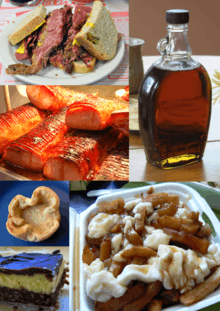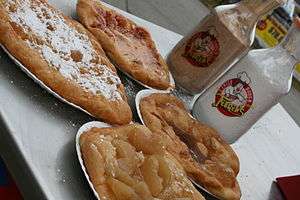Fried dough
|
Various fried dough toppings | |
| Alternative names |
fry dough fry bread fried bread doughboys elephant ears scones flying saucers buñuelos pizza fritte beaver tails |
|---|---|
| Course | Breakfast, dessert, or snack |
| Place of origin | Canada |
| Serving temperature | Warm |
| Main ingredients | Yeast dough |
| Variations | zeppole and others |
|
| |
Fried dough is a North American food associated with outdoor food stands in carnivals, amusement parks, fairs, rodeos, and seaside resorts (though it can be made at home). Fried dough is the specific name for a particular variety of fried bread made of a yeast dough; see the accompanying images for an example of use on carnival-booth signs. Fried dough is also known as fry dough, fry bread, fried bread, doughboys, elephant ears, scones, pizza fritte, funnel cake, frying saucers, and buñuelos (in the case of smaller pieces). These foods are virtually identical to each other, and recognizably different from other fried dough foods such as doughnuts, beignets, or fritters.
In Canada, pieces of fried dough are sometimes called beaver tails. According to Bill Castleman, a writer of books on Canadian word origins, the name referred to quick-baked dough "especially in early 19th-century places where people might camp for one night and where there was no frying pan."[1][2] In 1978, Pam & Grant Hooker of Ottawa, Ontario founded the BeaverTails chain of restaurants specializing in the sale of fried dough pastries which are hand stretched to the shape of a beaver's tail.
In Newfoundland, a province in Eastern Canada, fried dough is referred to as a "Touton". A touton /ˈtaʊtən is produced by frying bread dough on a pan with butter or the leftover fat from "scrunchions" (fried preserved pork) and served with dark molasses, maple syrup, or corn syrup. It is traditionally made from leftover bread dough and pan-fried, as opposed to deep-fried.
A smaller Italian variant common in North America is the zeppole.
Similar food is found in Europe, also typically from outdoor stands in fairs. For example, in Croatia fried dough is known as languši, in Hungary as lángos, in Austria as kiachl, in Germany as Knieküchle while the oliebol is eaten in the Netherlands.
A type of soft, fried dough ball frequently coated in sugar can be found in some Chinese restaurants in New York. These dough balls are referred to by any one of a number of names, including but not necessarily limited to "sugar biscuits", "Chinese doughnuts", or the simpler "fried bread".
Preparation
 |
| Part of a series on |
| Canadian cuisine |
|---|
|
Regional cuisines |
|
Religious and ethnic |
|
Fried dough is made by deep-frying a portion of risen yeast dough. The dough acquires an irregular, bubbly appearance from being fried.
The dough may then be sprinkled with a variety of toppings, such as granulated sugar, powdered sugar, cinnamon, fruit sauce, chocolate sauce, cheese, maple syrup, whipped cream, tomato sauce, garlic butter, lemon juice, honey, butter, nuts, or a combination of these.
 Fried Dough Stand - New England
Fried Dough Stand - New England Stretching Dough To Be Fried
Stretching Dough To Be Fried Mixing Dough To Be Fried
Mixing Dough To Be Fried Various Fried Dough Toppings
Various Fried Dough Toppings Fried Dough Sugar Table Where Toppings Are Added
Fried Dough Sugar Table Where Toppings Are Added Plating Fried Dough
Plating Fried Dough Frying Fried Dough
Frying Fried Dough Frying Fried Dough - Uncooked
Frying Fried Dough - Uncooked
See also
- Beignet
- Fried dough foods
- Frybread, a food of Native Americans
- Youtiao
- Funnel cake
- List of deep fried foods
- Zeppole
References
- ↑ Bill Castleman. "Canadian Food Words". Retrieved 2006-12-17.
- ↑ Russell Frank (1898) Explorations in the Far North University of Iowa. p. 39.
External links
| Wikimedia Commons has media related to Fried dough. |
- St. Petersburg (Florida) Times article, Distinction between funnel cakes and elephant ears